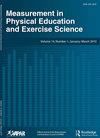有序分类指标的因子分析与体育活动情境中自我效能感的测量:一项实质-方法学的协同作用
IF 1.9
4区 教育学
Q2 EDUCATION & EDUCATIONAL RESEARCH
Measurement in Physical Education and Exercise Science
Pub Date : 2023-03-06
DOI:10.1080/1091367X.2023.2186789
引用次数: 0
摘要
运动机能学中有序分类指标的因子分析非常普遍。然而,在本研究中常用的方法中对指标所做的一些假设可能会增加分析误差。放宽这些假设的方法已经有几十年了,但吸收的速度很慢。因此,本教程的方法学重点是有序分类指标的因子分析。几十年来,自我效能感一直是体育活动研究中最重要的社会心理结构之一。不幸的是,在体育活动背景下构建自我效能量表的次优做法经常被观察到,并降低了对这些工具的反应产生的分数的效度。构建自我效能量表的指导方针已经有几十年的历史了,但坚持的程度仍然不一致。因此,本教程的实质重点是体育活动情境下自我效能感的测量。本教程的协同作用是对自我效能指标的模拟有序分类反应进行因子分析。提供了来自Mplus和R的注释文件。本文章由计算机程序翻译,如有差异,请以英文原文为准。
Factor Analysis with Ordered Categorical Indicators and Measurement of Self-Efficacy in Physical Activity Contexts: A Substantive-Methodological Synergy
ABSTRACT Factor analysis of ordered categorical indicators in kinesiology is pervasive. However, some assumptions made regarding the indicators within methods commonly used in this research may increase analytic errors. Methods that relax these assumptions have been available for decades, but uptake has been slow. Therefore, the methodological focus of this tutorial was factor analysis of ordered categorical indicators. Self-efficacy has been one of the most important psychosocial constructs in physical activity research for decades. Unfortunately, sub-optimal practices in constructing self-efficacy scales in physical activity contexts are frequently observed and decrease validity for scores produced from responses to these instruments. Guidelines for constructing self-efficacy scales have been available for decades, but adherence remains inconsistent. Therefore, the substantive focus of this tutorial was measurement of self-efficacy in physical activity contexts. The synergy within this tutorial was factor analysis of simulated ordered categorical responses to self-efficacy indicators. Annotated files from Mplus and R are provided.
求助全文
通过发布文献求助,成功后即可免费获取论文全文。
去求助
来源期刊

Measurement in Physical Education and Exercise Science
Medicine-Orthopedics and Sports Medicine
CiteScore
4.20
自引率
33.30%
发文量
24
期刊介绍:
The scope of Measurement in Physical Education and Exercise Science (MPEES) covers original measurement research, special issues, and tutorials within six substantive disciplines of physical education and exercise science. Six of the seven sections of MPEES define the substantive disciplines within the purview of the original research to be published in the journal: Exercise Science, Physical Activity, Physical Education Pedagogy, Psychology, Research Methodology and Statistics, and Sport Management and Administration. The seventh section of MPEES, Tutorial and Teacher’s Toolbox, serves to provide an outlet for review and/or didactic manuscripts to be published in the journal. Special issues provide an avenue for a coherent set of manuscripts (e.g., four to five) to collectively focus in-depth on an important and timely measurement-related issue within the scope of MPEES. The primary aim of MPEES is to publish high-impact manuscripts, most of which will focus on original research, that fit within the scope of the journal.
 求助内容:
求助内容: 应助结果提醒方式:
应助结果提醒方式:


